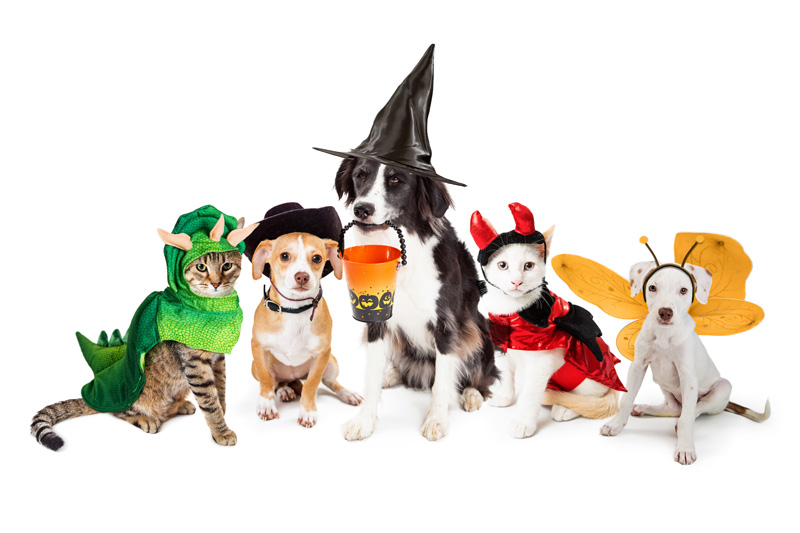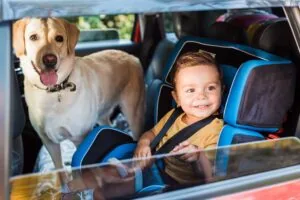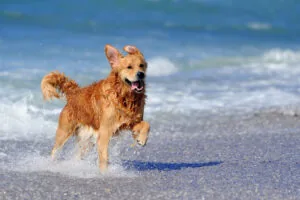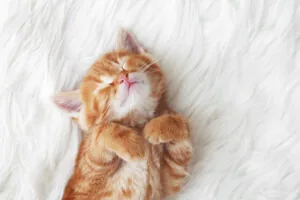Safety Tips for Our Pets on Halloween

There are few things in life cuter than seeing your terror-of-a-puppy dressed up in horns and a red cape on Halloween. But for dogs and their families, Halloween should also be a time for caution. To ensure that both your children and dogs enjoy a fun and safe holiday, please remember the following tips.
Leave Pets Inside/Comfortable
Give your pets a haven where they can feel safe, comfortable, relaxed and tucked away from any Halloween hazards. Keep pets confined and away from the door. Indoors is certainly better than outdoors on Halloween, but your door will be constantly opening and closing, and strangers will be on your doorstep dressed in unusual costumes. This, of course, can be scary for our furry friends, which can result in escape attempts or unexpected aggression. Putting your dog or cat in a secure crate or room away from the front door will reduce stress and prevent them from darting outside into the night.
Before the trick-or-treating starts, put your pets in a quiet room where they will be safe from all the Halloween activity. Even if you are just having friends over for a Halloween party, keep your pets away from the festivities in their safe room. Masks and costumes change how people look and smell to a pet, so even familiar people may become frightening. When going out trick-or-treating, leave your dog at home. Dogs can be easily excited by the Halloween commotion, and a bite or a lost dog will quickly end the evening’s fun.
Halloween Leash Safety
For pets that will join you trick-or-treating around the neighborhood, keep them on a leash the whole time. Leashes save lives! A leash will not only keep your pet from bolting in front of a passing car, but it will also help you prevent them from eating dropped candy, and other potentially dangerous things from the ground. Leashes also prevent dog fights and keep spooked dogs from running off.
If your dog or cat should escape and become lost, having the proper identification will increase the chances that he or she will be returned. Collars and tags are ideal if a Good Samaritan is able to collect your wayward pet, but microchips offer permanent identification should the collar or tag fall off. Just make sure the information is up-to-date. Use Halloween as a yearly reminder to double check your address and phone number on tags and with the company who supports pet microchips.
Dangerous Halloween Treats
Several popular Halloween treats are toxic to pets. Chocolate in all forms—especially dark or baking chocolate—can be very dangerous for cats and dogs, and sugar-free candies containing the sugar substitute xylitol can cause serious problems in pets.
Xylitol
Xylitol, a natural sugar alternative, is even more toxic to dogs than chocolate, its use is becoming increasingly common, and too many people are still unaware of the very real and serious dangers that xylitol poses to dogs. Hard candies, sugar-free gum, and even some chocolates are just a few of the many types of products that can contain xylitol.
If you have children, make sure they don’t leave their candy lying around anywhere that’s accessible to your dog. And be sure to hang any bags or purses up where your dog truly can’t reach them. Even just a small piece of gum like you would find in Ice Breakers Ice Cubes gum contains enough xylitol to severely sicken or even kill a small dog, and it doesn’t take much more than that to pose the same danger to larger dogs.
Chocolate
Chocolate is typically the reason behind most calls to veterinarians during this time of year. And yes, chocolate can be problematic for pets. The darker the chocolate, the more toxic and problematic it is for dogs and cats. This is because the concentration of theobromine, a caffeine-like compound found in chocolate, is higher the darker the chocolate is. While many people are aware of the danger chocolate poses to dogs, the same danger for cats is far less publicized.
Snack and Candy Bags
The actual treats in your kid’s Halloween bounty aren’t the only potential food-related problem for your pets — the wrappers and bags those treats come in can also cause problems. Ingested candy wrappers can lead to digestive system inflammation and/or obstruction, resulting in episodes of vomiting and/or diarrhea, as well as an unplanned trip to the veterinarian, and possibly the surgery table. Signs could include vomiting, decreased energy and/or appetite, or straining to defecate. Candy bags and salty snack (e.g., chips, pretzels, etc.) bags can also turn deadly in a matter of minutes.
If you suspect your pet has ingested something toxic, please call your veterinarian or the ASPCA Poison Control Center at (888) 426-4435 immediately. Keep treats away from your children unless you are observing them. Children may make the harmful mistake of sharing with their four-legged friends.
Halloween Decorations
While glow sticks can help keep people safe on Halloween night, they can add some unwanted drama to the holiday if a pet chews one open. Pets who get into a glow stick may drool, paw at their mouth, become agitated, and sometimes even vomit.
Keep Halloween plants such as pumpkins and corn out of reach. While small amounts of corn and pumpkin can be fed safely to many pets, ingesting uncooked, potentially moldy Halloween pumpkins or corn displays can cause big problems. Gastrointestinal upset is a possibility whenever pets eat something they aren’t used to, and intestinal blockage can occur if large pieces are swallowed.
Don’t keep lit pumpkins around pets. If you are using candles to light your jack-o-lanterns or other Halloween decorations, make sure to place them well out of reach of your pets. Should they get too close, they run the risk of burning themselves or causing a fire.
Keep electric and battery-powered Halloween decorations out of reach. Electric and battery-powered Halloween decorations are certainly safer than open candles, but they still can present a risk to pets. Pets who chew on electrical cords can receive a possibly life-threatening electrical shock or burn.
Costumes
For some pets, wearing a costume may cause undue stress. Don’t put your dog or cat in a costume unless you know he or she loves it. If you dress up your pet for Halloween, make sure the costume does not limit his or her movement, sight or ability to breathe, bark or meow. Check the costume carefully for small, dangling or easily chewed-off pieces that could present a choking hazard. Ill-fitting outfits can get twisted on external objects or your pet, leading to injury. Be sure to have your pet try on the costume before the big night. If he or she seems distressed or shows abnormal behavior, consider that a costume might not be right for your pet. Remove any chewable parts or objects that could come off and choke your pet.
Following these simple tips will help keep your dog safe, healthy and out of any scary trouble this Halloween.
Share This Post
Recent Posts
About Shallowford Animal Hospital
Shallowford Animal Hospital and The Pet Spa at Shallowford are dedicated to the exceptional, compassionate care your pet deserves. Pets hold a very special place in our families, and we treat yours like our own.



